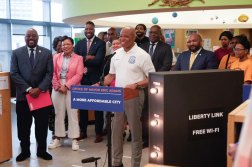‘A dozen’ big cities are designing or considering ‘digital twins’

New York City, Las Vegas and Phoenix have all recently committed to building virtual models of their downtown districts, hoping to develop new strategies to reduce carbon emissions and improve energy efficiency. But executing on the nascent “digital twin” technologies won’t be simple, experts told StateScoop.
Cityzenith, a Chicago-based data visualization company founded in 2009, is behind the rise of the virtual model technology, with “at least a dozen” U.S. cities considering piloting the technology in the next six months, CEO Michael Jansen told StateScoop. Jansen offers the data aggregation and visualization software for free to cities, universities and nonprofits. The company primarily works with business planning districts, like the 2030 Districts Network, a coalition of nonprofits around the U.S. and Canada dedicated to reducing emissions in city office buildings. While cities mostly have their eye on the technology for environmental improvements, the possibilities are wide open, said Dave Low, the Executive Director of 2030 Districts Network.
“If we start talking about ‘smart cities’ and everything, if you have a good digital twin of a city, you can really start doing some exciting things, not just on the individual building level,” Low said. “That’s really the next step for energy efficiency and carbon reduction, is working in congress with multiple building owners, multiple sites and doing everything together.”
The technology that CityZenith offers allows any sensor in a building that measures emissions, air quality, water and power consumption, noise or other factors to transmit data back into a central repository for analysis. The aggregated data is then used to create a “digital twin” of the building, or buildings, enabling everybody from academics and policymakers to building owners to simulate tests on how to reduce emissions without spending money to do it. Research on the technology from the consulting firm Ernst and Young this year revealed that digital twins can reduce greenhouse gas emissions in buildings by 50%, while also improving efficiency.
The concept of digital modeling isn’t new, Jansen said, but until recently, technology hadn’t caught up to the idea of community-sized digital models. It’s a “perfect storm” of technology and a nationwide commitment toward reducing carbon emissions that’s recruiting cities and infrastructure-focused nonprofits, Jansen said.
“We don’t use anything today like we did three years ago,” Jansen said. “There’s a lot of work that went into the core aggregation, visualization and analytics capabilities of the software, with a particular emphasis on ‘internet-of-things’ data because that’s so critical to what we do. That’s a lot of work.”
Cityzenith also charges individual buildings to offer “digital twins” for their energy systems, which is how the company is funded, Jansen said. But the work with cities will require the company to scale virtual models to entire neighborhoods, like the Brooklyn Navy Yard in New York City or downtown Las Vegas. With each building in those neighborhoods having their own systems, the complexity in each model required for a digital twin multiplies quickly, Low said.
“The execution has to happen. It’s easy to say on paper that this all looks good, but making it happen and getting building owners to jump on board and implement within their building so they’re getting all the information to Cityzenith or any digital twin — that’s the next step, which is not necessarily easy to make happen,” Low said.
Jansen is confident.
“We’re not going to do a gas station, brother,” he said. “We’re going to do huge stuff.”






